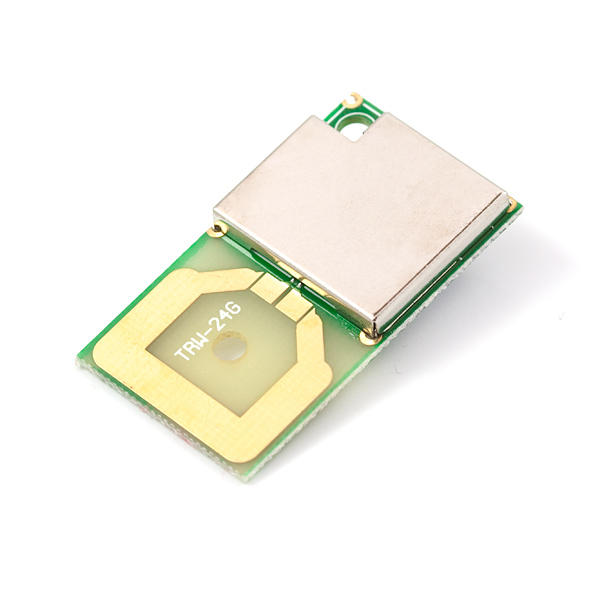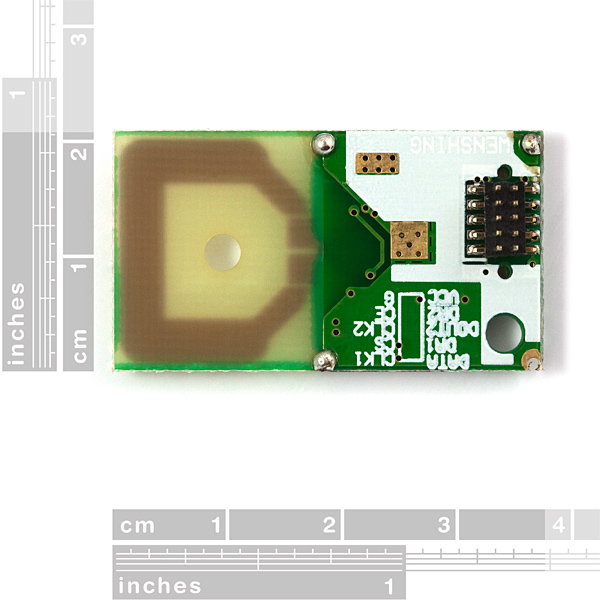Transceiver nRF2401A with Trace Antenna
Replacement: None. We do not have a direct replacement for this. It is discontinued and we will no longer carry it. This page is for reference only.
We have found a new supplier for this device. We recommend the SparkFun nRF2401A module as a replacement for the RF-24G if needed. Same IC, same commands, the difference is the MiRF v1 has a 0.1" connector.
****2.4GHz transceiver modules with built in antenna designed around the Nordic Semiconductor nRF2401. These are the latest gems from Laipac Tech. They incorporate a buffer that is loaded at any clock speed, once the transmit bit is set, all data is shot towards the receiving module at 1 million bits per second. Once the data has been successfully received by the other side, the data can be clocked out of the receive buffer at any rate. This drastically reduces current consumption by minimizing the time in active transmit mode. Please see the data sheet for a better description and more information.
Please note: These modules have a 1.25mm spacing header on them. You will either need to wire wrap for prototyping or mate with the appropriate female header. You may wish to add the 10-Pin breakout board for conversion to .1" standard breadboard spacing.
Check out our comparative range test!
****Specifications:****
- Frequency: 2.4~2.524 GHz
- Modulation type: GFSK
- Operating Voltage: 3V
- Output Power: +4dBm
- Data Rate: 1Mbps; 250Kbps
- Small footprint size: 20.0 x 36.7 x 2.4mm
- Operating Temperature: -40 ~ +85 C
- Long range: 280m @250Kbps ; 150m @1Mbps
- Built-in antenna
- Very low cost
- Applications: Telemetry, Wireless Toys, Remote Control, Wireless Speaker, Wireless Earphone or Walkie-Talkie, Wireless Mouse and Keyboard, Utility Meters Data Downloading, etc****
****Software: **
**
- Example PIC Code for 4-byte payload and 29-byte payload
****Supported Antennae:****Hah! It's built in!
Check out these handy calculators that help with antenna design.****
**Sold by **single units.****
Comments
Looking for answers to technical questions?
We welcome your comments and suggestions below. However, if you are looking for solutions to technical questions please see our Technical Assistance page.
Customer Reviews
No reviews yet.




Good transcievers. Hard to troubleshoot, but the example code is helpful. I used 3.4~3.7V for a few weeks, and burned out two of them. Stay below 3.3V!
Hi there
I have bought this module with complete development kit 2006-2007(4 year back)... That also include ICSP Programmer. I want to find that development kit, I am specially interested in the documentation and ICSP programmer for that kit. I am unable to find that development board (the one that i found is with USB programmer) I think administrator removed that link... I still have the hardware excluding ICSP programmer... I want to use it for some other project. Plz guide how can I find those the requested material... Thank you
Hi all,<br />
<br />
I think I make a very bad mistake. I pump in 5V for a few second (or may b a few minutes) but how could I know it is still working?<br />
<br />
Thanks,<br />
<br />
Bryan
Is this the same module? http://www.laipac.com/easy_trf24_eng.htm Because there a 50-100 m range is given.
Hey,
Has anyone used this, or any other long range and high-speed wireless transmitters with a Cypress PSoC? Sparkfun has lots of code for the AVR's, but I would prefer to use the PSoC since it can be ordered for free from Cypress.
What's a mts?
Its a wonderful little unit of measurement invented by the French. Also spelled meter, metre, mts (for metres) ect.
Wow - using mts for meters is very bad for readability. I come from New Zealand (i.e. I use the metric system all the time), and even I had no idea what it stood for. Sparkfun: correct SI style is to use 'm' to represent meters; preferably with a space between the number and the unit.
What's the difference between these and http://www.sparkfun.com/commerce/product_info.php?products_id=153
This module has a FIFO (first in first out) buffer that you can fill with data at any rate (so you don't need a fast microcontroller), then you set a transmit bit and it sends it out at 250kbps or 1Mbps depending on how you've configured it.
Page 21 in the RF-24G PDF above lists the following as the payload size:
- In Shock-Burst mode payload size is 256 bits minus the following: (Address: 8 to 40 bits. + CRC 8 or 16 bits).
- In Direct mode the payload size is defined by 1Mbps for 4ms: 4000 bits minus the following: (Preamble: 8 (or 4) bits. + Address: 8 to 40 bits. + CRC: 0, 8 or 16 bits).
So unless I'm wrong, you at worst have 200 bits - ie 25 bytes - to work with. The whole transmission itself is a bit bigger - the payload is just one of 4 "pieces" of a transmission (which are all mentioned in the PDF).
If I'm wrong, please do correct me! Also, listing the buffer size in the specs would probably be very convenient ;)
I?ve got two of them, let?s see how it works
Excellent product. Very easy to use, excellent example code. Descriptive paragraph should probably read "data is shot towards the receiving module at 1 million BITS per second."
Yep - sorry about that. Fixed now.